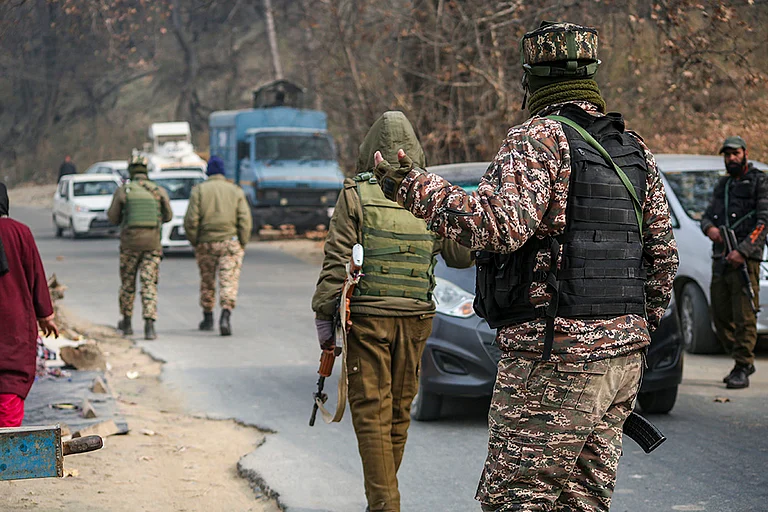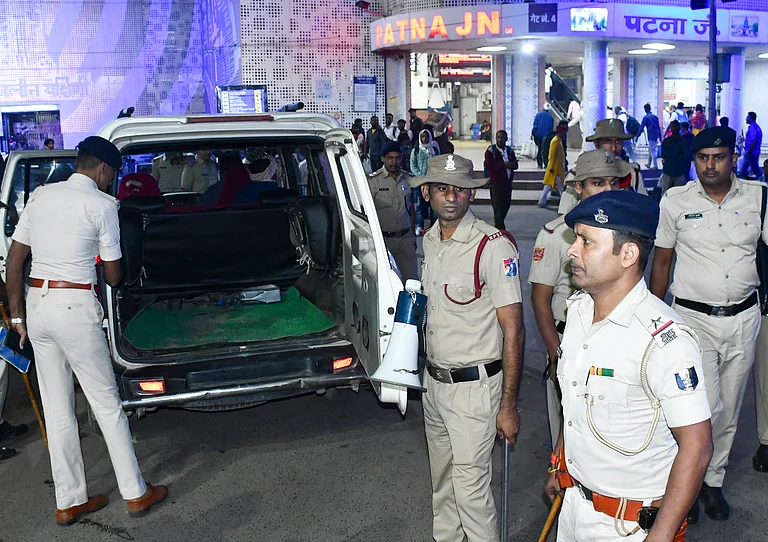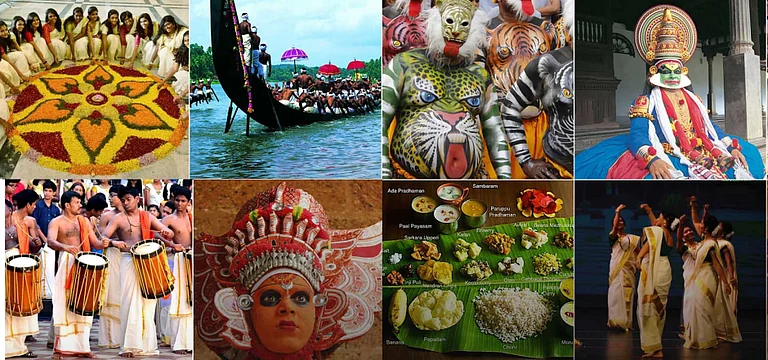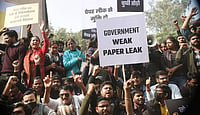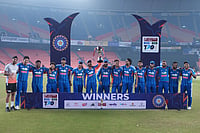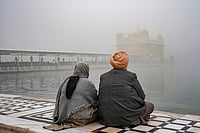
The historical gates of the Kangra Fort—the oldest and largest fort in the Himalayas—became the entry point to an art salon organised on October 4, centered around the theme of power.
‘Ten Nights By a Lost River’ featured 18 theatrical installations exploring power as a multitude of realities from aspiration, to myth, to symbolism, to empowerment, to the cycle or exchange of power.
With the theatrical stagings set in various locations throughout the fort, the audience discovered the venue while encountering performances and installations
The sun is melting into the horizon. A flock of white birds, on its way back home, flies past and disappears into the clouds that resemble fluffy cotton candies. As one starts to walk up the steps of the Kangra Fort—the oldest and largest fort in the Himalayas—the moon makes an appearance, overpowering the sun and the clouds.
With sharad purnima approaching, the big, white ball shines brightly amid the faintly twinkling stars. From the top, one can see Kangra city, gradually retiring for the day. Atop, there is silence, interrupted frequently by hundreds of crickets and other night elements. The theatrical spotlights placed across the fort play hide and seek with the dense darkness. Three performers, dressed in shimmery gold outfits, appear from one of the corners of the fort and start walking towards the audience standing in the main courtyard. Their walk is slow and seductive. One of them whispers in your ear: “Are you the one?” What do the three performers signify—the power of mystery, surrealism, magic?
As they gradually walk away from the central stage, the music changes, and the setting resembles a queen’s durbar. The spotlight is on a figure, wearing a blue robe and a feathered crown. She walks down the staircase with great flair, over the top melodrama and seduction. An energetic bullfighting music plays in the background. She then quietly disappears. The act depicts the power of illusion—something that once existed and then ceased to exist.
The music changes yet again, and the spotlight shifts back to the courtyard. Five young dancers break into an energetic hip-hop performance on the song ‘I’ve got the power’ by Snap!—a German Eurodance group formed in 1989. The peppy, foot-thumping music is in complete contrast to the fort’s serenity. The moves of the dancers signify the power of movement, of not stagnating, of living and thriving, of enthralling and entertaining. Once the music dies down, these five performers move to a still position in the left courtyard, representing the feeling of both tragedy and triumph amongst the ruins and remains of carved statues, broken columns and walls that no longer exist—a kind of theatre of its own. The contemporary performers are now at rest, like ghost-actors from the past.
The fifth chapter of the annual Panorama Editions—an international art salon—was organised at the Kangra Fort on October 4. Founded in 2017 by artist and filmmaker Sarah Singh, the vision of Panorama Editions is to bring site-inspired cultural experiences to important historical locations in collaboration with former royal families, to bring to the public the true value of historic patronage. The last two chapters—organised at the Jaisalmer and Gwalior forts—explored the themes of silence and desire, respectively. The latest edition was titled ‘Ten Nights by a Lost River’ and explored the theme of power.
“Himachal Pradesh is also known as dev bhoomi (the land of gods) and veer bhoomi (the land of the brave)—both represent power. Then there are the magnificent and magnetic mountains that are also the sources of power, as they serve as the origin of mighty rivers. Given the landscape, exploring the theme of power seemed natural,” says Singh. Incidentally, the region has, in the past few years, been ravaged by monsoon fury, leading to giant mountains crumbling and furious rivers gulping everything that came in their way. Is it another dimension of the power of nature—the kind that destroys?
What about the Kangra Fort then? An architectural marvel signifying the powerful emotions of bravery, resistance and valour, does, inadvertently, end up becoming the protagonist of the art salon. “He, who holds the Kangra Fort, holds the hills,” says a popular pahadi saying. Standing on a cliff in the lap of the Dhauladhar mountain range between the Manjhi and Banganga rivers, the fort is probably one of the oldest in the Himalayan region and has been the seat of the Katoch family, claimed to be one of the oldest dynasties of the Indian subcontinent—its references are found in Ramayan and Mahabharat. The fort has undergone the ravages of invaders and nature, yet its layered history, political legacy, strategic position and architecture provide a glimpse of the glory of ancient India. Pitch battles have been fought at the various gates of the fort, including the Ahini, Amiri, Andheri, Darshini and Jahangiri gates.
‘Ten Nights By a Lost River’ featured 18 theatrical installations exploring power as a multitude of realities from aspiration, to myth, to symbolism, to empowerment, to the cycle or exchange of power.
These historical gates became the entry point to the art salon on October 4. “I first visited the Kangra Fort way back in 2018. The moment I walked inside, I felt there was a possibility of great theatre in that space,” says Singh. Aishwarya Chand Katoch, the present head and the 489th king of the royal house of Kangra, agrees when he says: “The history of the fort resonates with the theme of power.” The Royal family of Lambagraon and Maharaja Sansar Chandra Museum—dedicated to Maharaja Sansar Chandra Katoch, a prominent ruler of the Kangra kingdom, known for his administrative abilities and patronage of the arts, especially the Kangra school of painting—were the event partners.
The art salon ‘Ten Nights’ (an expression of time) ‘By a Lost River’ (an expression of what was, what lies beneath, and what may be again) featured 18 theatrical installations exploring power as a multitude of realities from aspiration, to myth, to symbolism, to empowerment, to the cycle or exchange of power.
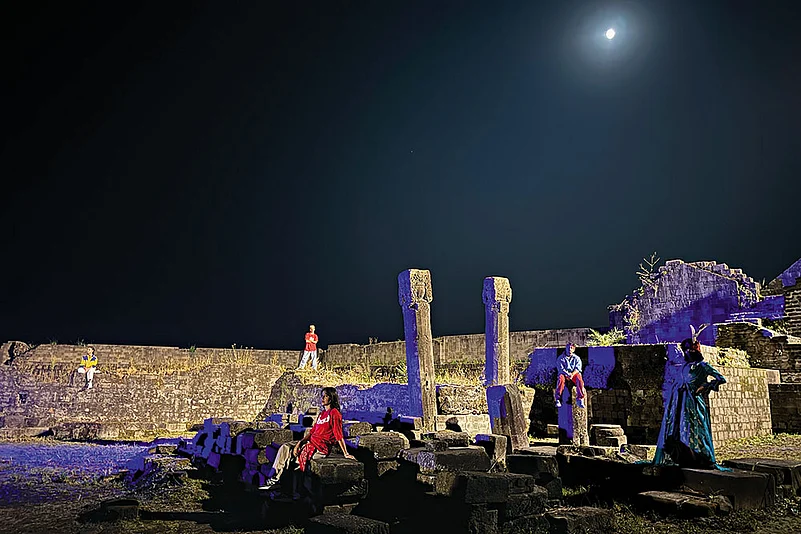
With the theatrical stagings set in various locations throughout the fort, the audience discovered the venue while encountering performances and installations—the walkabout added different perspectives and contexts to the contemporary stagings. Some performances were finite, while most were ongoing and continued throughout the one-hour experience. While some performers were from in and around Kangra—18 students from the National Institute of Fashion Technology (NIFT) and 10 locals—a dozen international artists and performers were from Austria, Hungary and Belgium. The entire premise was based on individual perceptions and interpretations, which gave the audiences the freedom to view and interpret the installations without any preconceived notions or baggage—it trickled down to your perception versus mine.
The fort’s security guards’ room became a staging ground for one of the performances. The set-up was that of a typical household and the two performers—both boys—were dressed very differently. While one was wearing a headgear that read ‘power lies in your head’, the movements of the other were demure as compared to the other. One was sitting on a high chair, while the other was moving around in that confined space. Who holds power then? The one sitting and looking up, or the one standing and looking down? As they moved around in that shared space, the power dynamics between the two were constantly changing. When their positions changed, much like in real life, the dynamics of the power equation changed as well.
In complete contrast to this performance, the room next door witnessed a static performance. The spotlight was on a trophy, kept amid various objects signifying ruin. The trophy represented the power of surviving, not giving up and emerging victorious.
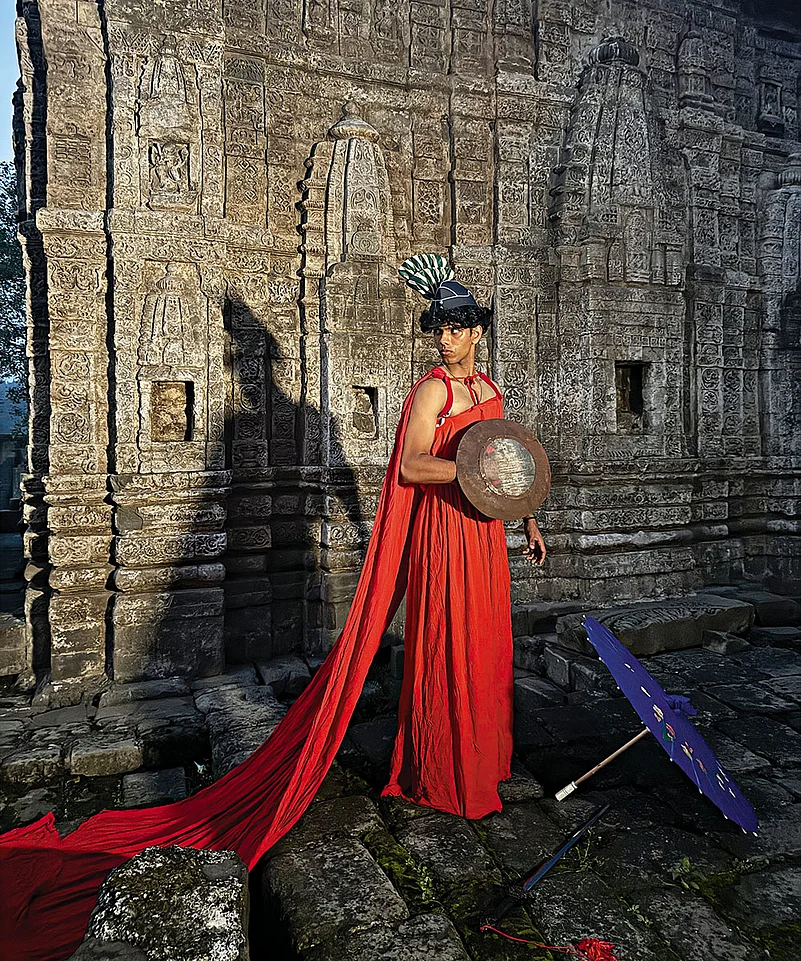
At another location, in the broken Lakshmi temple, eighty-year-old Belgian designer and stylist Lou Lou Van Damme—was moving around slowly in the given space, exploring self-empowerment. Hers was a quiet and poignant exploration of power.
In contrast, depicting the power of fierceness was a young performer in a slightly abstracted place with a broken tree behind her. She was on her own with her whip, where she was exploring her empowerment/frustration.
At the very top of the fort was a setting of a stylised and contemporary throne. It was cut by the anguish of Marilyn Monroe in the iconic image from the movie The Misfits where she is experiencing an utter breakdown and total loss of her own power as a reaction to what was happening around her in the desert, where the men were capturing wild horses, stealing their power and exerting power over the landscape. The setup, placed next to the throne, created a dialogue with light behind the arches.
The conclusion of the encounter at the fort was a tented encampment dinner on the grounds at the backside of the fort, across the river, where horses were originally trained for the Army in days gone by.
In the penultimate performance, two Hungarian acrobat artists, dressed in shimmery silver, left the audience enthralled with their moves—their act depicting the power of balance, strength and mutual trust.
The 18th theatrical staging occurred inside an old army tent on these grounds, showcasing luxurious handwoven carpets from Jaipur Rugs alongside distressed brocade curtains by New York designer Peter D’Ascoli. Amongst rows of discarded army helmets was a unique ceramic art object by Italian designer Andrea Anastasio, suggesting a prized object amongst the battlefields —the scene was both surreal and decadent, and utilitarian.
While the smart use of spotlights and flashlights brought the fort to life that night, artefacts, costumes and elements—both local and shipped from the cultural wings of embassies and institutes across several countries—acted as valuable collaborators and breathed life into each installation. These included custom garments from Sweden by fashion designer Pawel Robuta; a contemporary military hat by Portuguese designer Sofia Caldas; a wrestler’s mask from Mexico alongside an archival portrait of a female Mexican wrestler from the 1950s; iconic stool, light, and ceramic designed by Anastasio; an archival Gaucho belt and a historic portrait of General Jose de San Martin from Argentina; a wooden Mayan mask from Guatemala and a silent film by Irish artist Richard Malone titled Knights.
The local collaborations included design interventions by NIFT, Kangra; young hip hop dancers from the Kangra helmed by Pankaj Pathania; a special silk ikat lungi from Odisha-based brand Boito showcasing the traditional weave of the Warrior Turtle design and a couture coat, skirt and veil by Shefali Khanna. A special tea tasting by Dharamsala Tea Company was hosted at the Maharaja Sansar Chandra Museum during sunset, as a prelude to the fort visit. A detailed presentation at the high tea unveiled the exquisite world of Kangra paintings. On October 5, a grand public concert was organised at the Dharamshala Police Ground that marked the Indian premiere of Spanish act Le Parody by artist Sole Parody, accompanied by trumpet player Frank Santiuste.
“Power is central to our being, to who we are. It is at the heart of our sense of self, our self-confidence. Are we empowered, are we seeking power, are we exchanging power—there are so many layers to it. The idea was to explore this powerful emotion through the 18 installations,” says Singh. She says that, like each Panorama Editions, this time too, the audience went back with a sense of intrigue, wonder and having experienced something that was presented in a new, unique manner. “In today’s time, when all of us are glued to our screens and new technologies like Artificial Intelligence are taking over, it becomes all the more important to make an effort to go to a location and witness something as part of a shared and direct experience,” she says.
This story appeared as The Echoes A Fort Holds in Out of Syllabus, Outlook’s November 1 issue, which explored how the spirit of questioning, debate, and dissent—the lifeblood of true education—is being stifled in universities across the country, where conformity is prized over curiosity, protests are curtailed, and critical thinking is replaced by rote learning, raising urgent questions about the future of student agency, intellectual freedom, and democratic engagement.








